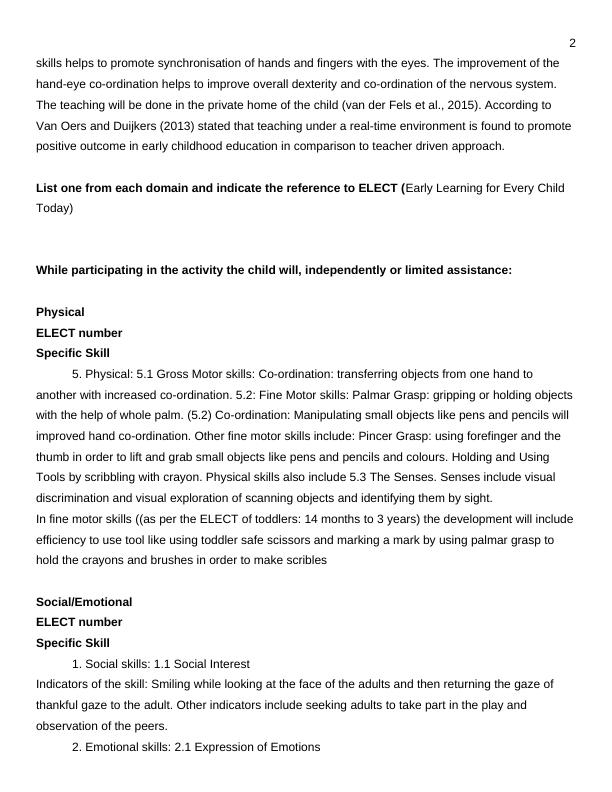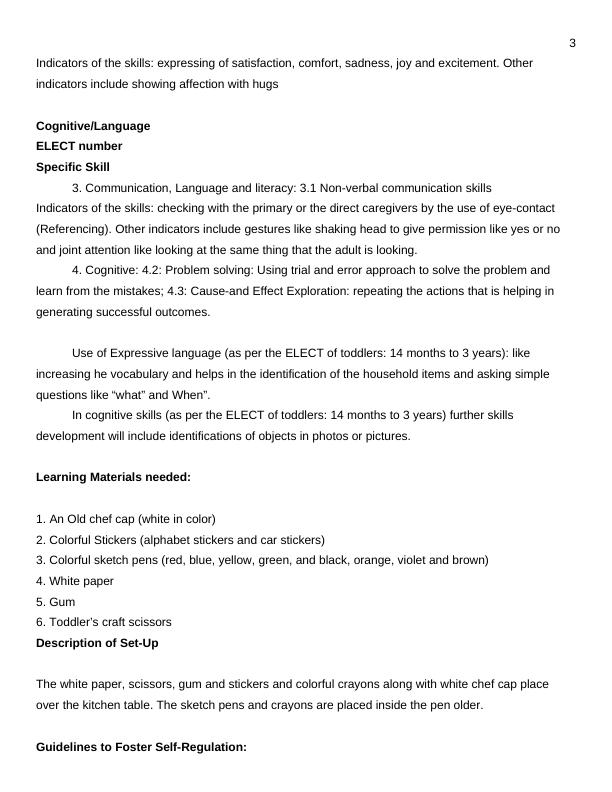Activity Plan for Literacy Development
Added on 2023-04-06
9 Pages2555 Words388 Views
Activity Plan
Preliminary Information:
Name of Student Educator: _______Lisa (pseudo-name)
Curriculum Area: Literacy Developmental Domain Familiarity with the alphabets, connecting
letter names and recognizing their names and learning to spell, read and write their names properly
Indoor:_______ Outdoor:_________
Age of Children: 24 months
Date of Implementation: 10th April
Resources Used to Prepare Plan (in APA format):
Children’s Resource or Storybook (in APA format, to be used as part of
activity-before/after/extend/enhance learning):
Part I – Planning
Rational for the activity (sentence form)
This kitchen activity will help to engage children like Andrew to improve their creative skills and
creative thinking and at the same time improve their literary skills like identification of alphabets and
colours. Writing the name of the child over the white old chef cap with colourful sketch pens and
pencil will help the child to get familiar with the alphabets, connecting with the letters, its
pronunciation and knowledge of different colours. The activity will also help the child (X) to read, write
and spell his name while helping to identify the name at once. The gripping of the pen will help to
improve the fine motor skills of the child. Fine motor skill helps to improve the dexterity. It helps to
improve the coordination of small muscles or the movements. The development of the fine motor
Preliminary Information:
Name of Student Educator: _______Lisa (pseudo-name)
Curriculum Area: Literacy Developmental Domain Familiarity with the alphabets, connecting
letter names and recognizing their names and learning to spell, read and write their names properly
Indoor:_______ Outdoor:_________
Age of Children: 24 months
Date of Implementation: 10th April
Resources Used to Prepare Plan (in APA format):
Children’s Resource or Storybook (in APA format, to be used as part of
activity-before/after/extend/enhance learning):
Part I – Planning
Rational for the activity (sentence form)
This kitchen activity will help to engage children like Andrew to improve their creative skills and
creative thinking and at the same time improve their literary skills like identification of alphabets and
colours. Writing the name of the child over the white old chef cap with colourful sketch pens and
pencil will help the child to get familiar with the alphabets, connecting with the letters, its
pronunciation and knowledge of different colours. The activity will also help the child (X) to read, write
and spell his name while helping to identify the name at once. The gripping of the pen will help to
improve the fine motor skills of the child. Fine motor skill helps to improve the dexterity. It helps to
improve the coordination of small muscles or the movements. The development of the fine motor

skills helps to promote synchronisation of hands and fingers with the eyes. The improvement of the
hand-eye co-ordination helps to improve overall dexterity and co-ordination of the nervous system.
The teaching will be done in the private home of the child (van der Fels et al., 2015). According to
Van Oers and Duijkers (2013) stated that teaching under a real-time environment is found to promote
positive outcome in early childhood education in comparison to teacher driven approach.
List one from each domain and indicate the reference to ELECT (Early Learning for Every Child
Today)
While participating in the activity the child will, independently or limited assistance:
Physical
ELECT number
Specific Skill
5. Physical: 5.1 Gross Motor skills: Co-ordination: transferring objects from one hand to
another with increased co-ordination. 5.2: Fine Motor skills: Palmar Grasp: gripping or holding objects
with the help of whole palm. (5.2) Co-ordination: Manipulating small objects like pens and pencils will
improved hand co-ordination. Other fine motor skills include: Pincer Grasp: using forefinger and the
thumb in order to lift and grab small objects like pens and pencils and colours. Holding and Using
Tools by scribbling with crayon. Physical skills also include 5.3 The Senses. Senses include visual
discrimination and visual exploration of scanning objects and identifying them by sight.
In fine motor skills ((as per the ELECT of toddlers: 14 months to 3 years) the development will include
efficiency to use tool like using toddler safe scissors and marking a mark by using palmar grasp to
hold the crayons and brushes in order to make scribles
Social/Emotional
ELECT number
Specific Skill
1. Social skills: 1.1 Social Interest
Indicators of the skill: Smiling while looking at the face of the adults and then returning the gaze of
thankful gaze to the adult. Other indicators include seeking adults to take part in the play and
observation of the peers.
2. Emotional skills: 2.1 Expression of Emotions
2
hand-eye co-ordination helps to improve overall dexterity and co-ordination of the nervous system.
The teaching will be done in the private home of the child (van der Fels et al., 2015). According to
Van Oers and Duijkers (2013) stated that teaching under a real-time environment is found to promote
positive outcome in early childhood education in comparison to teacher driven approach.
List one from each domain and indicate the reference to ELECT (Early Learning for Every Child
Today)
While participating in the activity the child will, independently or limited assistance:
Physical
ELECT number
Specific Skill
5. Physical: 5.1 Gross Motor skills: Co-ordination: transferring objects from one hand to
another with increased co-ordination. 5.2: Fine Motor skills: Palmar Grasp: gripping or holding objects
with the help of whole palm. (5.2) Co-ordination: Manipulating small objects like pens and pencils will
improved hand co-ordination. Other fine motor skills include: Pincer Grasp: using forefinger and the
thumb in order to lift and grab small objects like pens and pencils and colours. Holding and Using
Tools by scribbling with crayon. Physical skills also include 5.3 The Senses. Senses include visual
discrimination and visual exploration of scanning objects and identifying them by sight.
In fine motor skills ((as per the ELECT of toddlers: 14 months to 3 years) the development will include
efficiency to use tool like using toddler safe scissors and marking a mark by using palmar grasp to
hold the crayons and brushes in order to make scribles
Social/Emotional
ELECT number
Specific Skill
1. Social skills: 1.1 Social Interest
Indicators of the skill: Smiling while looking at the face of the adults and then returning the gaze of
thankful gaze to the adult. Other indicators include seeking adults to take part in the play and
observation of the peers.
2. Emotional skills: 2.1 Expression of Emotions
2

Indicators of the skills: expressing of satisfaction, comfort, sadness, joy and excitement. Other
indicators include showing affection with hugs
Cognitive/Language
ELECT number
Specific Skill
3. Communication, Language and literacy: 3.1 Non-verbal communication skills
Indicators of the skills: checking with the primary or the direct caregivers by the use of eye-contact
(Referencing). Other indicators include gestures like shaking head to give permission like yes or no
and joint attention like looking at the same thing that the adult is looking.
4. Cognitive: 4.2: Problem solving: Using trial and error approach to solve the problem and
learn from the mistakes; 4.3: Cause-and Effect Exploration: repeating the actions that is helping in
generating successful outcomes.
Use of Expressive language (as per the ELECT of toddlers: 14 months to 3 years): like
increasing he vocabulary and helps in the identification of the household items and asking simple
questions like “what” and When”.
In cognitive skills (as per the ELECT of toddlers: 14 months to 3 years) further skills
development will include identifications of objects in photos or pictures.
Learning Materials needed:
1. An Old chef cap (white in color)
2. Colorful Stickers (alphabet stickers and car stickers)
3. Colorful sketch pens (red, blue, yellow, green, and black, orange, violet and brown)
4. White paper
5. Gum
6. Toddler’s craft scissors
Description of Set-Up
The white paper, scissors, gum and stickers and colorful crayons along with white chef cap place
over the kitchen table. The sketch pens and crayons are placed inside the pen older.
Guidelines to Foster Self-Regulation:
3
indicators include showing affection with hugs
Cognitive/Language
ELECT number
Specific Skill
3. Communication, Language and literacy: 3.1 Non-verbal communication skills
Indicators of the skills: checking with the primary or the direct caregivers by the use of eye-contact
(Referencing). Other indicators include gestures like shaking head to give permission like yes or no
and joint attention like looking at the same thing that the adult is looking.
4. Cognitive: 4.2: Problem solving: Using trial and error approach to solve the problem and
learn from the mistakes; 4.3: Cause-and Effect Exploration: repeating the actions that is helping in
generating successful outcomes.
Use of Expressive language (as per the ELECT of toddlers: 14 months to 3 years): like
increasing he vocabulary and helps in the identification of the household items and asking simple
questions like “what” and When”.
In cognitive skills (as per the ELECT of toddlers: 14 months to 3 years) further skills
development will include identifications of objects in photos or pictures.
Learning Materials needed:
1. An Old chef cap (white in color)
2. Colorful Stickers (alphabet stickers and car stickers)
3. Colorful sketch pens (red, blue, yellow, green, and black, orange, violet and brown)
4. White paper
5. Gum
6. Toddler’s craft scissors
Description of Set-Up
The white paper, scissors, gum and stickers and colorful crayons along with white chef cap place
over the kitchen table. The sketch pens and crayons are placed inside the pen older.
Guidelines to Foster Self-Regulation:
3

End of preview
Want to access all the pages? Upload your documents or become a member.
Related Documents
Assignment 1B: Preliminary Activity Planlg...
|11
|1946
|186
Early Childhood Education and Care Methodslg...
|24
|6552
|22
Activities to Enhance Pre-Writing Skills in Childrenlg...
|5
|846
|74
EDU10002 Project 3: Learning Activity Planlg...
|5
|1894
|220
A Toy for Playlg...
|5
|858
|209
Evidence Supported Intervention Plans for Occupational Therapy | Deskliblg...
|8
|1189
|341
